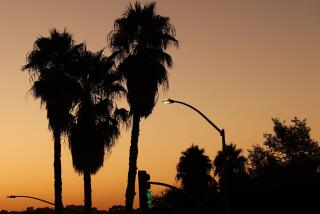Southland Experiences Warmest January on Record
- Share via
This has been the warmest January on record in the Los Angeles region. And, despite an El Nino condition that has led many forecasters to predict a wet winter, it’s been one of the driest too.
Forecasters say several records could be broken today as temperatures approach 90 degrees in the San Gabriel and San Fernando valleys and the mid-80s in Los Angeles and Orange counties.
“It will be about the same as it was Thursday,” said Don Whitlow, a meteorologist with the National Weather Service’s San Diego region, which covers Orange County -- where the temperature in Santa Ana reached 84 degrees, tying the record high for the day set in 1992.
It has been about 5 degrees warmer than normal this month in downtown Los Angeles, with an average temperature of 62.8 degrees, about half a degree warmer than the old January record of 62.2, set in 1994.
The warm, dry weather has been largely the product of a continuing series of high-pressure systems that have parked on or near the coast, said Stuart Seto, a meteorological specialist with the National Weather Service.
If it doesn’t rain today -- and it almost certainly won’t -- this will be only the fourth January since they started keeping records in 1878 that no measurable rain has fallen in downtown Los Angeles. The other years were 1948, 1972 and 1976.
But the weather service and the National Oceanic and Atmospheric Administration say the dry weather should end abruptly, with above normal rainfall in the Southwest during February, March and April.
Other meteorologists aren’t so sure.
The weather service expectations of wet weather are based largely on El Nino, a cyclical oceanic and meteorological phenomenon, driven by forces not fully understood, that seems to have a great influence on weather in Southern California.
Surface ocean temperatures fluctuate in the eastern equatorial Pacific. When those temperatures are relatively warm, high-altitude jet stream winds tend to drift south over California, carrying with them storm systems that often bring heavy rain to the Los Angeles area.
This year’s El Nino, expected to begin taking effect here within the next few weeks, is characterized as moderate, and Seto said that could mean as much as 7 or 8 inches of rain over the next three months. That would mean a total for the 2002-03 season of about 13 to 15 inches, close to normal.
More to Read
Sign up for Essential California
The most important California stories and recommendations in your inbox every morning.
You may occasionally receive promotional content from the Los Angeles Times.










